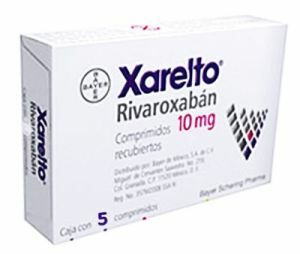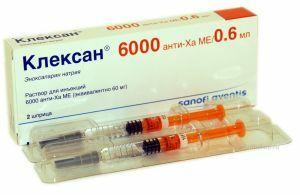 Rivaroxaban( trade name Xarelto) is an antithrombotic agent that is used to prevent and treat thrombosis of various genesis, in particular venous thromboembolism and PE.
Rivaroxaban( trade name Xarelto) is an antithrombotic agent that is used to prevent and treat thrombosis of various genesis, in particular venous thromboembolism and PE.
Rivaroxaban has a thinning effect on the blood condition, so before using it, consult a physician and carefully read the instructions for use.
Available in the form of round tablets. The structure of the tablets is white, the top is covered with an enteric coating.
The preparation contains the following components:
- active ingredient - rivaroxaban;
- additional substances that accelerate the absorption of the drug.
Contents
- Pharmacological profile
- What indications should I take the medicine
- Limitations and contraindications for use
- Dosage and dosage regimens
- Cases of overdose
- Side effects
- Special patients
- Physician's view
- How it is in practice
- Purchase of the drug and its analogues
Pharmacologicalprofile
Rivaroxaban belongs to the group of oral anticoagulants. It is an X-factor inhibitor. The molecular weight of the active component is 435.8 grams per mole.
During the coagulation process, the Stuart-Prower clotting factor plays a major role, its activation is due to internal and external tenase. Normally, in a normal state, coagulability factor Xa, in combination with a nonfert type cofactor Va and calcium ions, results in the formation of a specific prothrombinase complex on the platelet surface.
During the appearance of the complex, activation of the prothrombin transition into thrombin is observed. Thrombin, in turn,  provides the emergence of the process of polymerization of fibrogen, which is in a dissolved state in the plasma or in a clot-clot condition. The active constituent substance of the drug has suppression of the coagulation factor Xa, as a result, it causes the stopping of thrombogenesis processes.
provides the emergence of the process of polymerization of fibrogen, which is in a dissolved state in the plasma or in a clot-clot condition. The active constituent substance of the drug has suppression of the coagulation factor Xa, as a result, it causes the stopping of thrombogenesis processes.
After taking the tablets at a dose of 10 mg, the bioavailability level of the drug reaches 90%.There is complete or almost complete absorption of the active substance. The maximum distribution of the main component of the drug occurs 2-4 hours after the application of the tablets. With a joint admission with food, the medicine does not change the pharmacological properties.
The process of drug absorption depends on its area of release in the gastrointestinal tract. The degree of binding of the drug to plasma proteins can be about 92-95%, mainly the active element is bound by albumins.
Metabolites and Riboxin in an unchanged state are excreted by calcium secretion and with fecal masses.
When should you take the medicine
The drug Rivaroxaban is prescribed under the following conditions: 
- during prophylactic treatment of venous thromboembolism in patients who underwent severe orthopedic operations on the lower limbs;
- during thrombotic lesions of deep veins and pulmonary embolism;
- during preventive treatment in patients with atrial fibrillation with non-valent origin.
Limitations and contraindications for use
You can not use the medicine in the following cases:
- during allergic reactions to the main constituent of the drug;
- for patients who have clinically significant bleeding;
- if gastric ulcer has recently been transferred, as well as traumatic injuries, operative interventions on the brain or spinal cord, cerebral hemorrhages;
- is not recommended for patients who have vascular aneurysms and abnormal vascular function;
- during the presence of malignant neoplasms with an increased risk of bleeding;
- is not allowed in conjunction with other anticoagulants;
- for patients who have hepatic insufficiency and coagulopathy;
- in the presence of kidney diseases in chronic form;
- for women during pregnancy;
- for children and adolescents under 18;
- during breastfeeding.
Dosage and Administration Regimens
 Rivaroxaban should be taken orally when eating. Dosages and duration of administration depend on the patient's goals and age.
Rivaroxaban should be taken orally when eating. Dosages and duration of administration depend on the patient's goals and age.
If the patient has difficulty while swallowing the tablets, they can be crushed beforehand to a powdery state. If the tablet is taken in a crushed state, it should be diluted in water or in a liquid neutral diet. After taking the medicine, you must immediately eat.
The standard dose per day should not be more than 10 mg. You need to take it once a day.
During the prophylactic treatment of stroke, systemic thromboembolism in patients who have atrial fibrillation, you need to take 20 mg of the drug, once every 24 hours. If there are violations in the functioning of the kidney, the dose should be reduced to 15 mg. The duration of treatment should be determined by the attending physician.
During the treatment and prophylactic therapy of pulmonary embolism and thrombosis of the deep veins, 15 mg of medicament should be taken. The medicine is taken 2 times a day.
The duration of therapy is 21 days. After this period, you need to switch to a one-time intake of 20 mg of the drug.
The maximum dose level of the drug per day in the first stage of use should be no more than 30 mg, in the subsequent - no more than 20 mg. The course of treatment is 3 months, it all depends on the patient's condition and the effectiveness of therapeutic therapy.
Cases of overdose
If a single dose of the drug is more than 600 mg, then there are symptoms of an overdose - bleeding and other adverse reactions.
During the onset of overdose symptoms, gastric lavage is performed, activated charcoal is given and further symptomatic treatment is performed.
If bleeding occurs while taking the medication, then the drug will stop taking the medication. Treatment therapy is performed individually depending on the area and the level of bleeding.
Side effects of
During the application of Rivaroxaban, the appearance of blood from any tissue and organ can occur, which eventually leads to the appearance of posthemorrhagic anemia. Symptomatics and severity of this phenomenon have differences, sometimes it can lead to death.
During this side reaction, the following symptoms occur: a feeling of weakness, the appearance of pallor, dizziness, headaches, asthenia.
In addition to these conditions, other side effects may occur: 
- the onset of nausea, increased lactate dehydrogenase;
- may show an increase in ATP, sometimes amylase, bilirubin in the blood, alkaline phosphatase or lipase increases.
The following phenomena can rarely be observed:
- occurrence of allergic reactions on the skin, a feeling of itching, rashes and scabies;
- manifestation of allergic dermatitis, tachycardia, lowering of blood pressure;
- hemorrhages and hematomas can sometimes occur;
- appearance of bleeding gums, gemetemesis;
- symptoms of bleeding from the rectum, hematuria;
- the appearance of blood from the nose, blood discharge from the genitals;
- occurrence of fatigue and edema;
- occurrence of fever and general weakness, thrombocytopenia;
- occurrence of headaches, dizziness, pain in the legs and hands;
- increased levels of urea and creatinine;
- occurrence of pain in the abdomen, constipation or diarrhea;
- disruption of the digestive system;
- occurrence of vomiting and impaired liver function.
Special patients
 Rivaroxaban is not recommended for use during pregnancy, because the constituent components can have harmful effects on the child.
Rivaroxaban is not recommended for use during pregnancy, because the constituent components can have harmful effects on the child.
During the period of breastfeeding, it is also not recommended to take the medication, since the constituent components are included in the composition of breast milk.
It is contraindicated to take the drug for children and adolescents under 18 years of age, therefore it is not applied in pediatric practice.
Viewpoint of a doctor
Rivaroxaban is an anticoagulant that helps with various thrombotic diseases of veins. It is effective both at the initial stages of the disease, and on the neglected.
I've been assigning this tool to my patients for 10 years already. According to reviews of patients, this drug helps to completely cure thrombotic diseases. Sometimes there are side effects in the form of small bleeding and allergic reactions, but these symptoms quickly pass.
Phlebologist
How the situation is in practice
Review of the daughter of the patient of the phlebological department on the use of Rivaroxaban.
Mom is 58 years old, already for 20 years she has varicose veins and concomitant thrombosis. For a long time she could not even normal, the terrible pain she usually had by the end of the day. Staying on her feet for 2-3 hours for her is just an unbearable meal.
I decided to send her to the doctor for treatment, after the inspection she was prescribed the drug Rivaroxaban. She took it according to the doctor's recommended schedule within 3 months. After treatment, she became much better, the inflammation and swelling completely gone.
Julia, 35 years old
Purchase of the drug and its analogues
The price of packaging the drug Rivaroxaban under the trade name Xarelto with the number of 10 tablets 10 mg is 900 to 1500 rubles. The cost of packing with the number of tablets 14 pieces with a dosage of 15 mg is 1400 rubles.
Rivaroxaban analogues, which are available for purchase at pharmacy sales points, many of them are much cheaper:
- Arikstra;

- Xarelto;
- Clexan;
- Cleaver;
- Clopidex;
- Listaf;
- Myristin;
- Parsedil;
- Ribasan forte;
- Cincumar;
- Streptase;
- Tagren;
- Tyclid;
- Tickle;
- Trombo ACC.
